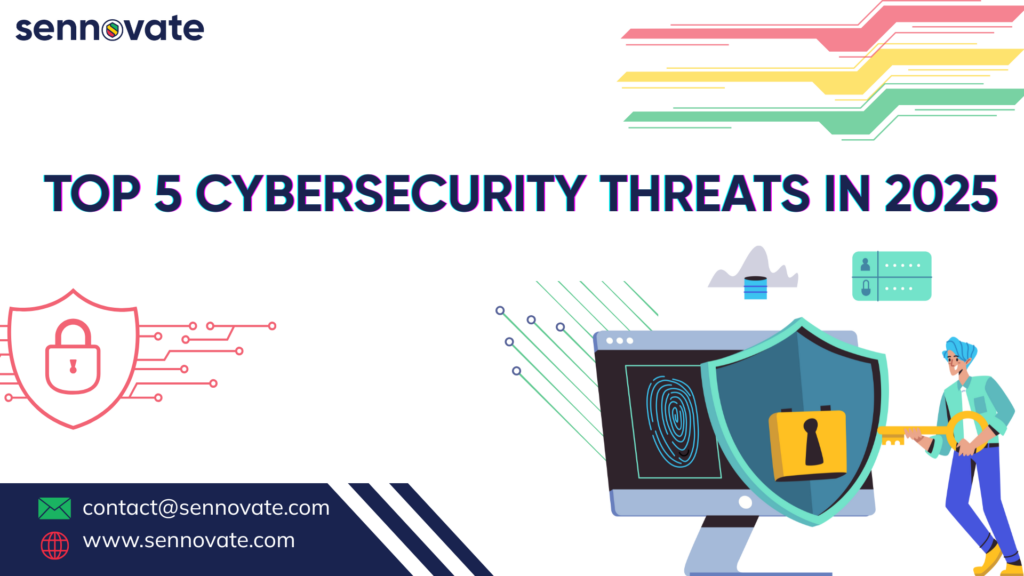

Top 5 Cybersecurity Threats of 2025 – Is Your Business Prepared?


As organizations increasingly adopt digital transformation, the landscape of cyber threats is advancing at an extraordinary rate. By 2025, we can expect to see more sophisticated attacks that utilize artificial intelligence, quantum computing, and advanced social engineering methods. It is essential for businesses in the United States and around the world to proactively address these threats to safeguard their data, customers, and overall reputation.
In this article, we will examine the five most significant cybersecurity threats anticipated for 2025, their potential consequences, and how collaborating with a premier cybersecurity services provider in the USA, such as Sennovate, can help protect your organization.
1. AI-Driven Cyberattacks – The Emergence of Autonomous Hacking
What is the Threat?
Cybercriminals are increasingly leveraging artificial intelligence (AI) and machine learning (ML) to automate their attacks, resulting in faster, more adaptable, and less detectable threats.
- AI-enhanced phishing: Attackers utilize AI to create highly personalized phishing emails that impersonate executives or trusted associates.
- Automated malware: Self-evolving malware can bypass conventional antivirus solutions by adapting in real-time.
- Deepfake social engineering: AI-generated audio and video scams deceive employees into transferring funds or divulging sensitive information.
How to Defend Against It?
- Implement AI-driven threat detection solutions (such as Sennovate’s MDR services) to identify and mitigate AI-based attacks.
- Provide regular training for employees on AI-related social engineering strategies.
- Adopt multi-factor authentication (MFA) and zero-trust security frameworks.
2. Quantum Computing Threats – The Encryption Dilemma
What is the Threat?
- Quantum computing: despite its groundbreaking potential, presents a significant danger to existing encryption protocols.
- Compromising RSA and ECC encryption: Quantum computers have the capability to dismantle prevalent encryption techniques, thereby jeopardizing confidential information.
- Harvest Now, Decrypt Later (HNDL) attacks: Cybercriminals may acquire encrypted data now with the intention of decrypting it in the future when quantum computing becomes widely accessible.
How to Prepare?
Begin the shift towards quantum-resistant encryption algorithms, such as those outlined in NIST’s post-quantum cryptography standards.
Collaborate with cybersecurity firms in the USA that provide assessments for quantum-ready security.
Utilize hybrid encryption models to safeguard sensitive information, integrating both classical and quantum-safe approaches.
3. Ransomware 3.0 – Double Extortion and Supply Chain Threats
What is the Threat?
Ransomware is advancing beyond mere file encryption. By 2025, we can expect:
- Triple extortion: Cybercriminals will not only encrypt data but also leak it and extort additional payments from customers and vendors.
- Ransomware-as-a-Service (RaaS): Malicious actors will lease ransomware tools from the dark web, making it easier for more individuals to engage in cybercrime.
- Supply chain attacks: Hackers will compromise a single vendor to gain access to numerous businesses, similar to the MOVEit breach that occurred in 2023.
How to Ensure Protection?
- Establish automated backups with air-gapped storage to mitigate data loss.
- Utilize endpoint detection and response (EDR) solutions to intercept ransomware before it can execute.
- Perform risk assessments on third-party vendors to enhance the security of supply chains.
4. Cyberattacks on IoT and OT – Targeting the Interconnected Environment
What is the Risk?
The Internet of Things (IoT) and Operational Technology (OT) systems, such as smart manufacturing facilities and medical equipment, are increasingly vulnerable to attacks.
- Botnet assaults: Infiltrated IoT devices can initiate Distributed Denial of Service (DDoS) attacks, exemplified by the Mirai botnet 2.0.
- Attacks on critical infrastructure: Cyber intrusions affecting power grids, water supply systems, and healthcare technologies.
- Insufficient security measures: Numerous IoT devices are equipped with weak default passwords and lack effective patching processes.
How to Reduce Risks?
- Isolate IoT/OT networks from essential IT infrastructures.
- Implement robust device authentication protocols and ensure regular firmware updates.
- Utilize network traffic monitoring systems to identify irregularities promptly.
5. Insider Threats – The Increasing Risk from Within
What is the Threat?
Threats are not solely external. According to IBM 2024, 34% of data breaches are attributed to either malicious or negligent insiders.
This includes disgruntled employees who may steal data prior to their departure, unintentional leaks resulting from inadequate security measures, and third-party contractors who possess excessive access rights.
How Can Insider Attacks Be Prevented?
- Utilize user behavior analytics (UBA) to identify unusual activities.
- Implement strict least privilege access controls.
- Provide ongoing security awareness training for all personnel.
Conclusion
The cybersecurity environment in 2025 is expected to be increasingly intricate, featuring challenges such as AI-driven assaults, quantum hacking, ransomware 3.0, vulnerabilities in IoT devices, and insider threats. Companies in the United States and around the globe must implement proactive security measures to ensure their protection.
How Sennovate Can Assist?
- As a premier provider of cybersecurity services in the United States, Sennovate delivers:
- Managed Detection & Response (MDR) – Continuous threat monitoring
- Zero Trust Architecture – Secure access for hybrid workforces
- Compliance & Risk Management – Adherence to NIST, ISO 27001, and CMMC standards
- Quantum-Safe Encryption Consulting
Do not wait for an incident to occur—fortify your defenses now.
Reach out to Sennovate for a complimentary cybersecurity assessment and stay ahead of the threats anticipated in 2025!



